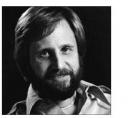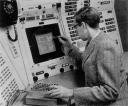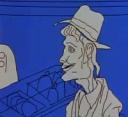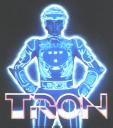1960 – LISP (List Processing Language) Programming Language was developed by John McCarthy for artificial intelligence applications.
1962 – The Sketchpad System was developed by Ivan Sutherland for Interactive Computer Graphics.
1964 – Boeing in Seattle created a 3D Animation of an aircraft carrier landing. Plotted drawings were done by William Fetter and W. Bernhart.
1966 – Hummingbird was created by Charles Csuri. This was the first example of computer generated animation.
1971 – Robert Abel & Associates opens.
Animated Faces were created by Fred I. Parke at the University of Utah.

1972 – Ed Catmull developed an animation scripting language and he created an animation of a smooth shaded hand.
This was at the University of Utah.
Also at the University of Utah, Fred Parke created the first computer generated facial animation.
MAGI animated computer-rendered polygonal objects.
1974 – The National Research Council of Canada released ‘Hunger/La Faim’. This was a short film that was directed by Peter Foldes and made use of interactive keyframing techniques.
1979 – Computer group opens at George Lucas’ Industrial Light and Magic.
1981 – A few companies opened, these would focus on 3D Animation.
Wavefront, Santa Barbara.
Digital Productions, Los Angeles.
R. Greenburg Associates (RGA), New York.
Polygon Pictures, Tokyo.
1982 – ‘Tron’ was the first movie with over 20 minutes of computer animation in it. The movie was rubbish but it helped contribute to the acceptance of CG Animation in Hollywood.
In Star Trek II; The Wrath of Khan, The Genesis Effect was the first fully animated visual effects shot.
1983 – Bill Reeves at Lucafilm published techniques for modelling particle systems.
Silicon Graphics Inc. opens. Also! Alias Research and Omnibus Computer Graphics opened in Toronto.
1984 – ‘Still Life Etude’ was an early simulation of light, fog, rain and skies. This was created at Hiroshima University.
Porter and Duff at Lucasfilm published a paper on digital compositing using an alpha channel. This paved the way for effectively combining live action and CG Imagery.
Also! Pixar opened.
1985 – At OSU, Girard and MacieJewski published a paper describing the use of inverse kinematics and dynamics for animation. Their techniques have become an accepted part of 3D animation today.
This guy called Ken Perlin also published a paper on noise functions for textures. He was from NYU. He applied this technique to add realism to character animations.
‘The Last Starfighter’ was the first live action feature film to use realistic computer generated models in place of traditional models.
Abel and Associates produced ‘Brilliance’, a commercial which featured a sexy female robot which had convincing realistic motion.
1986 – ‘Luxo Jr’ by John Lasseter was nominated in the AMPAS Animated Short Category.
Softimage opened in Montreal and VIFX in Los Angeles.
1987 – John Lasseter at Pixar published a paper describing traditional animation methods.
Blue Sky Studios opened in New York.
Side Effects Software opened in Toronto.
Stanley and Stella: Breaking the Ice by Symbolics Graphics and Whitney Demo Productions contains early flocking animation.
1988 – ‘Locomotion’, a short film by Pacific Data Images was an early example of squash and stretch.
1989 – ‘Knickknack’ a short film by pixar
‘Don’t Touch Me’ by Kleiser-Walczak was an early character animation using motion capture techniques.
1991 – Terminator 2 was the first mainstream blockbuster movie to use multiple morphing effects and simulated natural human motion. This set the standard for CG animation and effects to follow.
1992 – ‘Aladdin’ is Disney’s first film to contain a fully computer animated character.
‘The Seven Wonders Of The World’ by Electric Images highlights a new way to produce architectural visualisation by pushing back the boundaries.
1993 – Jurassic Park sets the standard for using Inverse Kinematics in creating realistic living creatures.
Babylon 5, the sci-fi TV series is produced with entirely off the shelf computers and software using Lightwave 3d and Amiga computers.
1994 – The wildebeest stampede in Disney’s ‘The Lion King’ is a spectacular integration of 3d computer animation flocking systems with traditional animation.
1995 – Toy Story was released to huge commercial and critical success and was the first full length 3D CG feature film.
1996 – ‘The Fight’, a short film by Acclaim Entertainment proves the viability of motion capture for character animation.
1997 – Pixar’s ‘Geris Game’ by Jan Pinkava is modelled with subdivision surfaces.
1998 – ‘Antz’ by Dreamworks/PDI
‘A Bug’s Life’ by Disney/Pixar
‘Bunny’ by Chris Wedge at Blue Sky Studios.
‘Bingo’ by Chris Landreth created using Alias/Wavefront’s new software, Maya.
1999 – ‘Toy Story 2’
Warner Brothers ‘Iron Giant’ uses computer animation to great effect in animating the title character.
‘Fishing’ by PDI presents a watercolour rendering effect.
‘Fiat Lux’ by Paul Debevec is a landmark in image based rendering.
2000 – Pixar’s ‘For the Birds’ by Ralph Eggleston
Victor Navones ‘Alien Song’ proves incredibly popular and is widely viewed on the web
The debut of PS2, XBOX and Gamecube boosted the quantity and quality of 3D animation being produced.
2001 – Pixar short ‘Mike’s New Car’ by Pete Docter and Roger Gould.
Dreamwork’s ‘Shrek’ won an oscar for the newly created award, Best Animated Feature. ‘Jimmy Neutron’ and ‘Monsters Inc’ are runners up.
Lord of the Rings: The Fellowship of the Ring was released pushing the boundaries on 3D animation and compositing.
Final Fantasy: The Spirits Within is the first fully 3D animated feature film to contain CG actors. Although it was technically brilliant, it failed at the box office.
2002 – Lord of the Rings 2 created a unique character in Gollum by using a combination of performance capture and keyframe animation.
Blue Sky Studios released ‘Ice Age’.
Filed under: CG Pipeline Research |














well, just forgeting Jim`s Clark and SGI was the pioneers of cgi, nothing here will be done without his vision